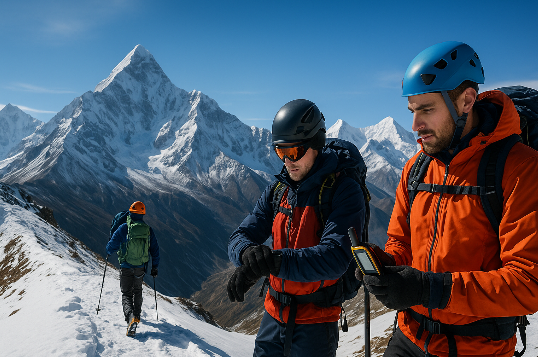Mountaineering has never been a walk in the park. Harsh weather, unpredictable terrain, and the sheer remoteness of many peaks have long made alpine expeditions some of the most dangerous human endeavors. But over the last decade, technology has radically reshaped how climbers approach these challenges. From the icy ridges of the Himalayas to the volcanic craters of the Andes, tools like GPS trackers, drones, and smart sensors are becoming as essential as ropes and crampons.
Contents
GPS Tracking: Precision in Every Step
GPS tech is now essential in mountaineering. Devices like smartwatches and handheld trackers help climbers navigate more confidently, even in whiteouts or glacial terrain. Accurate location tracking also aids in route planning and reduces the risk of getting lost in low visibility.
In the Himalayas, GPS data helps avoid unstable paths, guides teams through shifting routes, and supports rescue efforts by providing precise locations in real time. Some teams now pre-load routes and elevation data to maximize efficiency and safety in unpredictable conditions. As a result, climbers spend less time on guesswork and more on execution.
With digital tools increasingly integrated into outdoor sports, adventurers benefit from features like Crazytime.games.
Drones: Eyes in the Sky
Drones are now indispensable for climbers. They scout terrain, check snow conditions, and assess avalanche risks. High-resolution aerial views offer a safer way to plan challenging sections.
In 2023, drones on Annapurna delivered oxygen and gear to stranded climbers—faster and safer than traditional methods. Some expedition teams also use drones to document their progress and identify backup routes in real time.

Sensors and Wearables: Real-Time Health and Environment Monitoring
Altitude sickness can hit even the most experienced climbers. Wearable health sensors, such as pulse oximeters and smart fitness bands, are becoming standard tools for high-altitude expeditions. These devices monitor vital signs like heart rate, blood oxygen levels, and temperature. When signs of hypoxia or exhaustion are detected, climbers can take preventative action before things spiral.
Environmental sensors, often clipped to backpacks or built into tents, monitor temperature, barometric pressure, and air quality. For example, sudden pressure drops can signal incoming storms. Some sensor systems sync with mobile apps to provide alerts and historical data trends, enhancing situational awareness.
Here are a few advantages of wearable tech in mountaineering:
- Improved health tracking: Early detection of symptoms like altitude sickness.
- Continuous monitoring: Enables climbers to respond quickly to health or environmental warnings.
- Data sharing: Syncs with base camp teams or medics for expert guidance.
These tools make it easier to stay safe and act decisively during high-stress situations.
Communication and Data Sharing: Staying Connected at Altitude
Staying connected in the mountains used to mean waiting until someone returned to camp. Today, satellite messengers and portable Wi-Fi devices allow climbers to send updates, receive weather reports, and call for help if needed. Some high-altitude base camps now operate with solar-powered satellite stations, making it possible to coordinate rescue missions or adjust plans based on up-to-date information.
Live data sharing has improved team coordination. For example, if one group encounters a blocked pass, they can immediately notify others. This level of connectivity improves safety and efficiency.
Common communication tools used in modern expeditions:
- Satellite messengers (e.g., Garmin inReach): Send texts and SOS alerts.
- Two-way radios: Essential for camp-to-climber communication.
- Mobile weather services: Deliver real-time forecasts via satellite or cached downloads.
Reliable communication reduces isolation and empowers climbers with the knowledge they need to make informed decisions.
Enhanced Safety: A Game Changer
Safety has always been a climber’s top concern. With these technologies, risk can be better managed, if not eliminated. Drones identify crevasses; GPS maps out detours around avalanche zones; health sensors provide real-time alerts.
Some expeditions now include a dedicated “tech lead,” a team member responsible for handling drones, syncing GPS data, and maintaining wearable devices. This role is increasingly vital on complex or commercial climbs.
Here are some technology-driven safety practices now common in alpine expeditions:
- Pre-summit route scanning with drones
- Daily GPS syncing and route logging
- Environmental monitoring at all camps
While none of these tools replaces experience and judgement, they provide a vital layer of support.
Conclusion
The integration of advanced technologies into mountaineering has revolutionized how climbers prepare, execute, and survive their expeditions. GPS navigation, aerial drones, wearable sensors, and satellite communication systems have brought new levels of safety, planning, and adaptability. As these tools become more accessible and reliable, they are redefining the boundaries of what’s possible in high-altitude climbing.
For today’s mountaineer, digital gear is just as crucial as physical strength and endurance. The mountain may still be wild, but climbers now face it with sharper tools and clearer eyes.

Ross, an exam specialist with a passion for education, writes comprehensive articles on exam results and admit cards. His expertise ensures students receive reliable information and useful tips to excel in their exams.


























